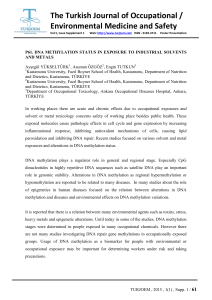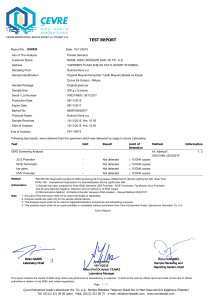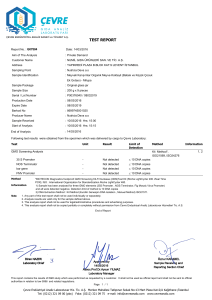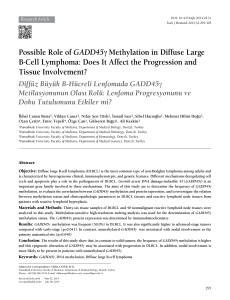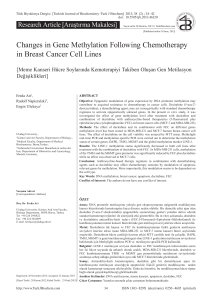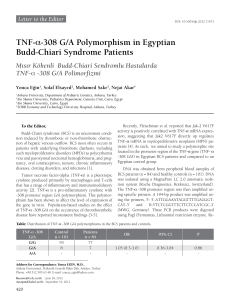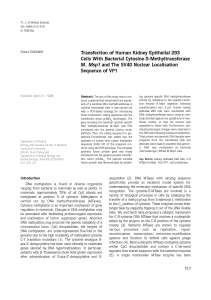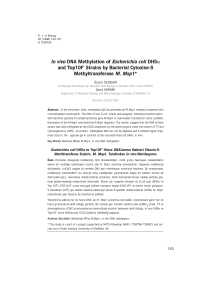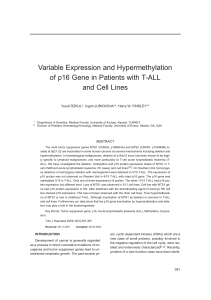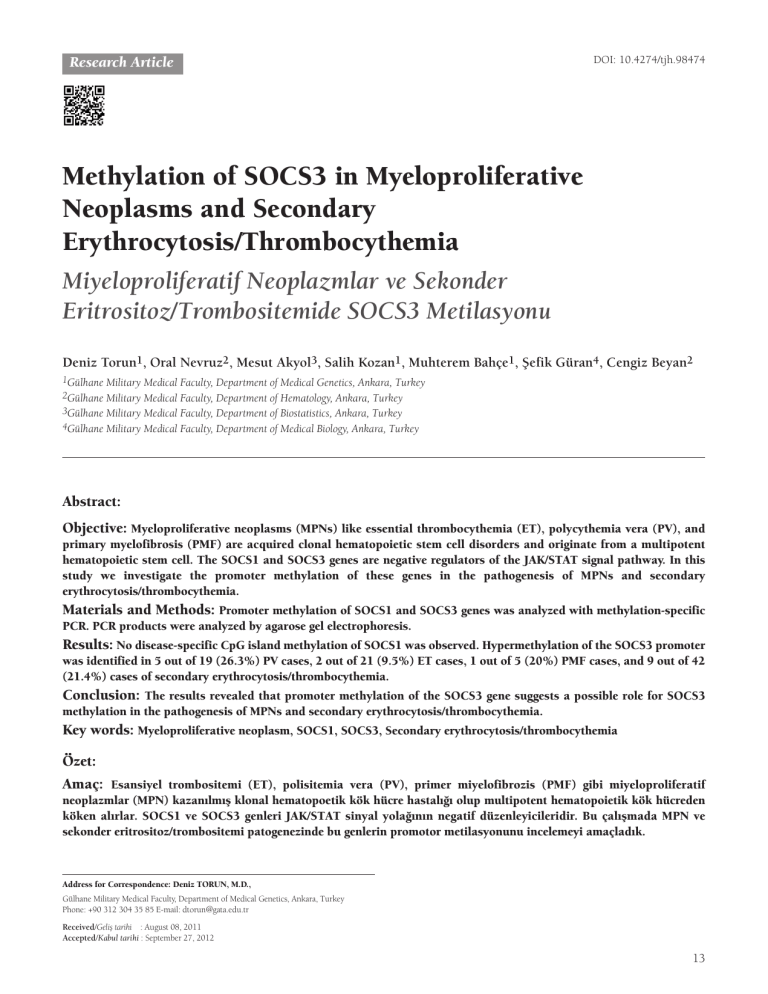
Research Article
DOI: 10.4274/tjh.98474
Methylation of SOCS3 in Myeloproliferative
Neoplasms and Secondary
Erythrocytosis/Thrombocythemia
Miyeloproliferatif Neoplazmlar ve Sekonder
Eritrositoz/Trombositemide SOCS3 Metilasyonu
Deniz Torun1, Oral Nevruz2, Mesut Akyol3, Salih Kozan1, Muhterem Bahçe1, Şefik Güran4, Cengiz Beyan2
1Gülhane Military Medical Faculty, Department of Medical Genetics, Ankara, Turkey
2Gülhane Military Medical Faculty, Department of Hematology, Ankara, Turkey
3Gülhane Military Medical Faculty, Department of Biostatistics, Ankara, Turkey
4Gülhane Military Medical Faculty, Department of Medical Biology, Ankara, Turkey
Abstract:
Objective: Myeloproliferative neoplasms (MPNs) like essential thrombocythemia (ET), polycythemia vera (PV), and
primary myelofibrosis (PMF) are acquired clonal hematopoietic stem cell disorders and originate from a multipotent
hematopoietic stem cell. The SOCS1 and SOCS3 genes are negative regulators of the JAK/STAT signal pathway. In this
study we investigate the promoter methylation of these genes in the pathogenesis of MPNs and secondary
erythrocytosis/thrombocythemia.
Materials and Methods: Promoter methylation of SOCS1 and SOCS3 genes was analyzed with methylation-specific
PCR. PCR products were analyzed by agarose gel electrophoresis.
Results: No disease-specific CpG island methylation of SOCS1 was observed. Hypermethylation of the SOCS3 promoter
was identified in 5 out of 19 (26.3%) PV cases, 2 out of 21 (9.5%) ET cases, 1 out of 5 (20%) PMF cases, and 9 out of 42
(21.4%) cases of secondary erythrocytosis/thrombocythemia.
Conclusion: The results revealed that promoter methylation of the SOCS3 gene suggests a possible role for SOCS3
methylation in the pathogenesis of MPNs and secondary erythrocytosis/thrombocythemia.
Key words: Myeloproliferative neoplasm, SOCS1, SOCS3, Secondary erythrocytosis/thrombocythemia
Özet:
Amaç: Esansiyel trombositemi (ET), polisitemia vera (PV), primer miyelofibrozis (PMF) gibi miyeloproliferatif
neoplazmlar (MPN) kazanılmış klonal hematopoetik kök hücre hastalığı olup multipotent hematopoietik kök hücreden
köken alırlar. SOCS1 ve SOCS3 genleri JAK/STAT sinyal yolağının negatif düzenleyicileridir. Bu çalışmada MPN ve
sekonder eritrositoz/trombositemi patogenezinde bu genlerin promotor metilasyonunu incelemeyi amaçladık.
Address for Correspondence: Deniz TORUN, M.D.,
Gülhane Military Medical Faculty, Department of Medical Genetics, Ankara, Turkey
Phone: +90 312 304 35 85 E-mail: [email protected]
Received/Geliş tarihi : August 08, 2011
Accepted/Kabul tarihi : September 27, 2012
13
Torun D, et al: Effect of SOCS3 Methylation in MPNs
Turk J Hematol 2013;30:13-18
Gereç ve Yöntemler: SOCS1, SOCS3 genlerinin promotor metilasyonu, metilasyon spesififk PCR ile incelendi. PCR
ürünleri agaroz jel elektroforezinde analiz edildi.
Bulgular: SOCS1 geninde CpG adacıklarında hastalıkla ilişkili metilasyon bulunamadı. 19 PV olgusunun 5’inde (%26,3),
21 ET olgusunun 2’sinde (%9,5), 5 PMF olgusunun 1’inde (%20), 42 sekonder eritrositoz/trombositemi olgusunun 9’unda
(%21,4) SOCS3 promotor metilasyonu saptandı.
Sonuç: SOCS3 geni promotor metilasyonu MPN ve sekonder eritrositoz/trombositemi patogenezinde etkili olarak
görünmektedir.
Anahtar Sözcükler: Miyeloproliferatif Neoplazi, SOCS1; SOCS3; Sekonder eritrositoz/trombositemi
Introduction
Myeloproliferative neoplasms (MPNs) are a group of diseases
of the bone marrow in which excess cells are produced. They are
related to, and may evolve into, myelodysplastic syndrome (MDS)
and acute myeloid leukemia (AML), although the MPNs on the
whole have a much better prognosis than these conditions. The
classic MPNs are polycythemia vera (PV), essential
thrombocythemia (ET), primary myelofibrosis (PMF), and
chronic myelogenous leukemia (CML). They were originally
grouped together based on their shared phenotype of
myeloproliferation [1]. All of these neoplasms are acquired clonal
hematopoietic stem cell disorders, originating from a multipotent
hematopoietic stem cell. Cytogenetic and/or molecular genetic
analyses are mandatory for differential diagnosis. Apart from the
BCR/ABL rearrangement in CML, the JAK2 and MPL mutations
play a crucial role in the pathogenesis of PV, ET, and PMF [2,3].
The JAK-STAT signaling pathway transmits information from
chemical signals outside the cell, through the cell membrane, and
into gene promoters on the DNA in the cell nucleus, which causes
DNA transcription and activity in the cell [4]. The suppressor of
cytokine signaling (SOCS) proteins inhibit the cytokine signaling
cascade by using the JAK/STAT pathway in a cell [5]. Expression
of SOCS1 and SOCS3 genes leads to reduced JAK and STAT
phosphorylation via binding of the JH1 domain and cytokine
receptor of JAK, respectively [6,7,8]. Epigenetic mechanisms such
as DNA methylation regulate DNA structure and gene expression
in a cell. Abnormal epigenetic mechanisms take place in the
development of many diseases, including cancer. Downregulation
of a gene due to methylation has been demonstrated in various
studies, including the SOCS1 and SOCS3 genes [9,10,11].
In this study, the effects of aberrant methylation of CpG
islands within the promoter region of SOCS1 and SOCS3 genes
were demonstrated in the pathogenesis of PV, ET, PMF, and
secondary erythrocytosis/thrombocythemia.
Materials and Methods
This study was approved by the appropriate local ethics
committee. Participants were ascertained according to the 2008
World Health Organization (WHO) classification system [1].
Written informed consent was obtained from all participants. A
cohort of 87 patients, which included 19 cases of PV, 21 cases of
ET, 5 cases of PMF, and 42 cases of secondary
erythrocytosis/thrombocythemia, was enrolled to investigate the
14
role of SOCS1 and SOCS3 promoter methylation. The control
group comprised 29 healthy individuals. JAK2 V617F mutation
analysis was used in differential diagnosis of MPNs and secondary
erythrocytosis/thrombocythemia.
Mutation Analysis of JAK2 V617F: DNAs were isolated from
peripheral blood samples in each case by using the NucleoSpin
Blood Kit (Macherey-Nagel, Germany). JAK2 V617F mutation
was determined in RT-PCR analyses by using a kit (JAK2 Type 1
PCR System, Dr Zeydanlı, Ankara, Turkey). The PCR conditions
were 95 °C for 10 min, followed by 32 cycles of 95 °C for 15 s
and 60 °C for 1 min.
Methylation Analysis of SOCS1 and SOCS3 CpG Islands:
Genomic DNA from patients and controls were modified with
sodium bisulfite using the CpGenomeTM Fast DNA Modification
Kit (Chemicon International, USA and Canada). The efficacy of
bisulfite modification was assessed with methylated control
samples (CpG WIZ® DAP-kinase Amplification Kit, Chemicon).
Bisulfite-modified DNA samples were amplified by methylationspecific PCR by using methylation-specific primers and
unmethylation-specific primers for the promoter region of SOCS1
and SOCS3 genes, as described by Liu et al. and Fourouclas et al.,
respectively [10,11]. The primer sequences and their locations
relative to the transcription start sites were noted as follows:
SOCS1-MF 5’-TTGTTCGGAGGTCGGATTT-3’ (nt -291 to 272); SOCS1-MR 5’-ACTAAAACGCTACGAAACCG-3’ (nt -93 to 74); SOCS1-UF 5’-TTTTTTGGTGTTGTTTGGAGGTTGGATTTT-3’
(nt -301 to -272); SOCS1-UR 5’-AAAACAAAACAATAAACTA
AAACACTACAAAACCA-3’ (nt -108 to -74); SOCS3-MF 5’GAGGGGTCGTTGTTAGGAAC-3’ (nt -1265); SOCS3-MR 5’ACAAAAACCGAAAAAAACGC-3’ (nt -1176); SOCS3-UNF
5’-GGAGGGGTTGTTGTTAGGAAT-3’ (nt -1266); SOCS3-UNR 5’CAAAAACAAAAACCAAAAAAAACA-3’ (nt -1175) [10,11].
Bisulfite-modified DNA samples from patients and controls
were amplified by PCR reaction in a total reaction volume of 25 μL
containing 1X PCR buffer (Bioron, Germany), 1.5 mM MgCl2, 0.2
mM dNTP, 0.4 pmol of each primer for SOCS1, and 1 pmol of each
primer for SOCS3, using 1.5 U hot-start Taq polymerase (Bioron)
on a thermal cycler (Bio-Rad, USA). The PCR conditions were 95
°C for 5 min, followed by 40 cycles of 95 °C for 30 s, 60 °C for 40
s, and 72 °C for 40 s with a final extension at 72 °C for 10 min.
PCR products were visualized using agarose gel electrophoresis.
Statistical Analysis: Statistical analysis was performed using
SPSS 15.00 for Windows (SPSS Inc., Chicago, IL, USA) and
Microsoft Excel 2003. The Shapiro-Wilks test was used to assess
Turk J Hematol 2013;30:13-18
Torun D, et al: Effect of SOCS3 Methylation in MPNs
normal distribution. Descriptive data are expressed as
mean±standard deviation. Skewed data are shown as median and
interquartile range (IQR). Chi-square (chi-square, Fisher exact, or
likelihood ratio) tests were used for comparisons of JAK2 and
SOCS3 among sub-groups. Categorical data are shown as numbers
and percentages. The level of significance was set at p≤0.05.
Results
JAK2 V617F mutation and methylation analysis of
SOCS1/SOCS3 CpG islands were performed in 45 cases of MPNs,
42 cases of secondary erythrocytosis/thrombocythemia, and for
29 control individuals. Age, sex, and blood count characteristics
of all patients and controls are summarized in Table 1.
JAK2 V617F mutation as observed in our series is summarized
in Table 2. Seventeen out of 19 PV patients (89.5%), 11 out of 21
ET patients (52.4%),and 2 out of 5 PMF patients (40.0%) revealed
JAK2 V617F mutations. The JAK2 V617F mutation was not
observed in secondary erythrocytosis/thrombocythemia patients
or in the healthy control group (Table 2).
SOCS1 and SOCS3 CpG island methylation patterns of the
study groups are presented in Table 2. The CpG islands analyzed in
SOCS1 and SOCS3 genes were inside the promoter regions of these
genes. MPN patients, secondary erythrocytosis/thrombocythemia
patients, and the control group were negative for the methylation of
the SOCS1 promoter region (Figure 1; Table 2). Five out of 19 PV
patients, 2 out of 21 ET patients, 1 out of 5 ET patients, and 9 out
of 42 secondary erythrocytosis/thrombocythemia patients revealed
hypermethylation of the SOCS3 promoter region (Figure 2; Table
2). The control group was negative for the methylation of the SOCS3
promoter region. Four out of 5 PV patients and 2 out of 2 ET
patients carrying methylation of the SOCS3 promoter region were
concurrently positive for the JAK2 V617F mutation.
Table 1: Age, sex, and blood count characteristics of the patients and control subjects.
Primary disorder
Polycythemia vera
Essential thrombocythemia
Primary myelofibrosis
Secondary erythrocytosis/thrombocythemia
Controls
Participants Sex
(n = 116)
19
21
5
42
29
WBC
(×103/μL),
median
(IQR)
RBC
(×106/μL),
Hg (g/dL),
median
(IQR)
Platelets
(×103/μL),
(IQR)
51
12.70
7.15±1.00
18.20
373.00
(31–77)
(11.60)
(1.38)
(200.50)
8F
55
(15–78)
9.55
(11.41)
6.58±0.77
17.20
(3.75)
418.00
(326.50)
13 M
42
(23–80)
8.00
(5.28)
5.13±0.54
15.00
(1.80)
799.50
(522.25)
8F
51
(30–78)
8.90
(7.08)
5.16±1.22
13.95
(2.78)
575.00
(243.50)
4M
61
(53–73)
11.23
(16.26)
4.38±1.62
10.25
(10.03)
227.00
(434.75)
1F
76
(76)
27.00
(27.00)
6.58±N/A
14.30
(14.30)
819.00
(819.00)
31 M
37
(18–78)
9.00
(9.00)
5.76 ±
N/A***
18.20
(18.20)
N/A***
11 F
51
(13–76)
13.00
(13.00)
N/A***
11.60
(11.60)
840.00
(840.00)
23 M
37
(27–45)
10.45
(6.68)
5.82±0.94
18.00
(2.45)
204.00
(104.50)
6F
36
(29–42)
8.10 (4.15)
11 M
Age*
χ±sd **
4.70±0.82 13.80 (3.65)
588.00
(523.00)
*Mean
**Mean±standard deviation
***Not available
15
Turk J Hematol 2013;30:13-18
Torun D, et al: Effect of SOCS3 Methylation in MPNs
Discussion
N1
M’
1M
1U
N2
Control
2M 2U
M
U
Figure 1: Methylation-specific PCR amplification of SOCS1
promoter region. U: unmethylated, M: methylated, M’: molecular
weight marker (100 bp). N1-N2: unmethylated. Presence of bands
in control groups indicates the efficacy of bisulfite treatment.
N1
M’
N2
N3
N4
Control
1M 1U 2M 2U 3M 3U 4M 4U M
U
Figure 2: Methylation-specific PCR amplification of SOCS3
promoter region. U: unmethylated, M: methylated, M’: molecular
weight marker (100 bp). N1-N2: unmethylated, N3-N4:
methylated. Presence of bands in control groups indicates the
efficacy of bisulfite treatment.
Classification of MPNs was based on the clinical phenotype of
these disorders and histological patterns. In recent years, many
advances have occurred in the understanding and management of
MPNs. Updated WHO classification of MPNs was primarily based
on the proliferation capacity of the cell lines and the amount of
bone marrow fibrosis. These findings were combined with clinical,
laboratory, and cytogenetic/molecular genetic features [1,12].
As an acquired mutation, JAK2 V617F plays a key role in the
pathogenesis of MPNs [2,13,14,15]. The JAK2 protein is a
cytoplasmic tyrosine kinase and takes part in signal transduction
[16]. A single amino acid substitution (valine to phenylalanine)
in the JAK2 tyrosine kinase encoding gene causes uncontrolled
hematopoiesis. JAK2 V617F mutation was reported in 90%-95%
of PV, 50% of PMF, and 40%-50% of ET patients in the literature
[17,18,19]. In our study, 89.5% of PV, 52.4% of ET, and 40.0%
of PMF patients revealed JAK2 V617F mutation. These results
were in line with previous reports. Secondary erythrocytosis/
thrombocythemia patients and the control group were negative
for the JAK2 V617F mutation, as expected.
Epigenetic changes, which are important for transcriptional
control, may cause various diseases [20]. In our series, the SOCS1
promoter region did not reveal any methylation patterns in MPN
patients, secondary erythrocytosis/thrombocythemia patients, or
the control group. These findings suggest that methylation of the
SOCS1 promoter region does not emerge as a molecular
mechanism during the progression of MPNs and secondary
erythrocytosis/thrombocythemia. These results are similar to those
of a previously reported study in the literature [11].
SOCS3 promoter methylation represents an important
mechanism in the pathogenesis of MPNs. Recently, Fourouclas
et al. reported the methylation of SOCS3 in 32.0% of patients
with PMF [11]. Our results show differences in some aspects. In
our study, PV (26.3%) and ET (9.5%) patients also revealed
SOCS3 promoter methylation, in addition to the PMF patients.
This finding suggests that promoter methylation of the SOCS3
gene not only plays a role in the pathogenesis of PMF but also
plays a key role in the pathogenesis of PV and ET.
Table 2: Frequency of JAK2 V617F and SOCS1/SOCS3 promoter methylation in the study groups.
Primary disorder
Participants
(n = 116)
JAK2
V617F
SOCS1
Polycythemia vera
19
17 / 19 (89.5%)
0 / 19 (0.0%)
5 / 19 (26.3%)
4/5
Essential thrombocythemia
21
11 / 21 (52.4%)
0 / 21 (0.0%)
2 / 21 (9.5%)
2/2
Primary myelofibrosis
5
2 / 5 (40.0%)
0 / 5 (0.0%)
1 / 5 (20.0%)
Secondary erythrocytosis/thrombocythemia
42
0 / 42 (0.0%)
0 / 42 (0.0%)
9 / 42 (21.4%)
Controls
29
0 / 29 (0.0%)
0 / 29 (0.0%)
0 / 29 (0.0%)
Total
116
30
0
17
(*): JAK2 V617F and SOCS3 promoter methylation evident in the same patient.
16
SOCS3
(*)
Turk J Hematol 2013;30:13-18
Torun D, et al: Effect of SOCS3 Methylation in MPNs
We next compared the MPNs among themselves for the
frequency of SOCS3 promoter methylation. SOCS3 promoter
hypermethylation did not exhibit any statistical difference among
PV, ET, and PMF (p>0.05). This finding suggests that SOCS3
promoter hypermethylation may be a useful finding in the definition
of MPNs but cannot be used as a tool of differential diagnosis.
In this study, secondary erythrocytosis/thrombocythemia
patients were also analyzed for SOCS3 promoter methylation. In
this group, 9 out of 42 (21.4%) patients revealed aberrant SOCS3
promoter methylation. It seems that the agents that play a crucial
role in the pathogenesis of secondary erythrocytosis/
thrombocythemia may show the effects through epigenetic
changes. To our knowledge, the finding of SOCS3 promoter
methylation in secondary erythrocytosis/ thrombocythemia has
been revealed here for the first time in the literature, but longterm clinical and laboratory follow-up is needed to observe the
effect of hypermethylation on the course of disease and whether
or not the hypermethylation abates.
The coincidental association of SOCS3 promoter methylation
and JAK2 V617F mutation is an important finding. Four out of 5
PV patients and 2 out of 2 ET patients carrying methylation of the
SOCS3 promoter region were concurrently positive for the JAK2
V617F mutation and statistical analysis revealed that the
presence/absence of JAK2 V617F mutation had no effect on the
existence of SOCS3 promoter methylation (p>0.05). These
findings represent the fact that promoter methylation in the
SOCS3 gene and the JAK2 V617F mutation might be
independent. However, this finding should be supported with
SOCS3 mRNA expression studies, and clinical outcomes of the
patients must be compared to establish its importance in the
pathogenesis and prognosis of MPN progression.
In conclusion, SOCS3 promoter hypermethylation represents
a crucial epigenetic event in the pathogenesis of MPNs and
secondary erythrocytosis/thrombocythemia. For long-term clinical
affects, further studies are needed.
Acknowledgment
This study was supported by the Gülhane Military Medical
Academy Research and Development Center, Ankara, Turkey.
References
1. Wadleigh M, Tefferi A. Classification and diagnosis of
myeloproliferative neoplasms according to the 2008 World
Health Organization criteria. Int J Hematol 2010;91:174-179.
2. Levine RL, Wadleigh M, Cools J, Ebert BL, Wernig G, Huntly
BJ, Boggon TJ, Wlodarska I, Clark JJ, Moore S, Adelsperger J,
Koo S, Lee JC, Gabriel S, Mercher T, D'Andrea A, Fröhling S,
Döhner K, Marynen P, Vandenberghe P, Mesa RA, Tefferi A,
Griffin JD, Eck MJ, Sellers WR, Meyerson M, Golub TR, Lee
SJ, Gilliland DG. Activating mutation in the tyrosine kinase
JAK2 in polycythemia vera, essential thrombocythemia, and
myeloid metaplasia with myelofibrosis. Cancer Cell
2005;7:387-397.
3. Daly S, Conneally E, Langabeer SE. Identification of MPL
W515L/K mutations in patients with primary myelofibrosis
and essential thrombocythaemia by allele-specific polymerase
chain reaction. Acta Haematol 2009;121:221-222.
4. Aaronson DS, Horvath CM. A road map for those who don’t
know JAK-STAT. Science 2002;296:1653-1655.
5. Greenhalgh CJ, Hilton DJ. Negative regulation of cytokine
signaling. J Leukoc Biol 2001;70:348-356.
6. Starr R, Hilton DJ. Negative regulation of the JAK/STAT
pathway. Bioessays 1999;21:47-52.
7. Sasaki A, Yasukawa H, Shouda T, Kitamura T, Dikic I,
Yoshimura A. CIS3/SOCS-3 suppresses erythropoietin (EPO)
signaling by binding the EPO receptor and JAK2. J Biol Chem
2000;275:29338-29347.
8. Yasukawa H, Misawa H, Sakamoto H, Masuhara M, Sasaki A,
Wakioka T, Ohtsuka S, Imaizumi T, Matsuda T, Ihle JN,
Yoshimura A. The JAK-binding protein JAB inhibits Janus
tyrosine kinase activity through binding in the activation loop.
EMBO J 1999;18:1309-1320.
9. Johan MF, Bowen DT, Frew ME, Goodeve AC, Reilly JT.
Aberrant methylation of the negative regulators RASSFIA,
SHP-1 and SOCS-1 in myelodysplastic syndromes and acute
myeloid leukaemia. Br J Haematol 2005;129:60-65.
10. Liu TC, Lin SF, Chang JG, Yang MY, Hung SY, Chang CS.
Epigenetic alteration of the SOCS1 gene in chronic myeloid
leukaemia. Br J Haematol 2003;123:654-661.
11. Fourouclas N, Li J, Gilby DC, Campbell PJ, Beer PA, Boyd EM,
Goodeve AC, Bareford D, Harrison CN, Reilly JT, Green AR,
Bench AJ. Methylation of the suppressor of cytokine signaling
3 gene (SOCS3) in myeloproliferative disorders. Haematologica
2008;93:1635-1644.
12. Vannucchi AM, Guglielmelli P, Tefferi A. Advances in
understanding and management of myeloproliferative
neoplasms. CA Cancer J Clin 2009;59:171-191.
13. James C, Ugo V, Le Couédic JP, Staerk J, Delhommeau F, Lacout
C, Garçon L, Raslova H, Berger R, Bennaceur-Griscelli A,
Villeval JL, Constantinescu SN, Casadevall N, Vainchenker W.
A unique clonal JAK2 mutation leading to constitutive signalling
causes polycythaemia vera. Nature 2005;434:1144-1148.
14. Baxter EJ, Scott LM, Campbell PJ, East C, Fourouclas N,
Swanton S, Vassiliou GS, Bench AJ, Boyd EM, Curtin N, Scott
MA, Erber WN, Green AR; Cancer Genome Project. Acquired
mutation of the tyrosine kinase JAK2 in human
myeloproliferative disorders. Lancet 2005;365:1054-1061.
15. Kralovics R, Passamonti F, Buser AS, Teo SS, Tiedt R, Passweg
JR, Tichelli A, Cazzola M, Skoda RC. A gain-of-function
mutation of JAK2 in myeloproliferative disorders. N Engl J
Med 2005;352:1779-1790.
16. Ugo U, Marzac C, Teyssandier I, Larbret F, Lécluse Y, Debili N,
Vainchenker W, Casadevall N. Multiple signaling pathways are
involved in erythropoietin-independent differentiation of
erythroid progenitors in polycythemia vera. Exp Hematol
2004;32:179-187.
17
Torun D, et al: Effect of SOCS3 Methylation in MPNs
17. Jones AV, Kreil S, Zoi K, Waghorn K, Curtis C, Zhang L, Score
J, Seear R, Chase AJ, Grand FH, White H, Zoi C, Loukopoulos
D, Terpos E, Vervessou EC, Schultheis B, Emig M, Ernst T,
Lengfelder E, Hehlmann R, Hochhaus A, Oscier D, Silver RT,
Reiter A, Cross NC. Widespread occurrence of the JAK2
V617F mutation in chronic myeloproliferative disorders.
Blood 2005;106:2162-2168.
18
Turk J Hematol 2013;30:13-18
18. Oh ST, Gotlib J. JAK2 V617F and beyond: role of genetics and
aberrant signaling in the pathogenesis of myeloproliferative
neoplasms. Expert Rev Hematol 2010;3:323-337.
19. Thiele J. Philadelphia chromosome-negative chronic
myeloproliferative disease. Am J Clin Pathol 2009;132:261-280.
20. Choo KB. Epigenetics in disease and cancer. Malays J Pathol
2011;33:61-70.

